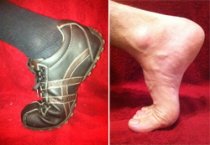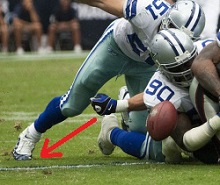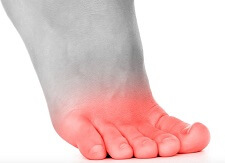- Home
- Common Foot Problems
- Turf Toe
Turf Toe
Written By: Chloe Wilson BSc(Hons) Physiotherapy
Reviewed By: FPE Medical Review Board
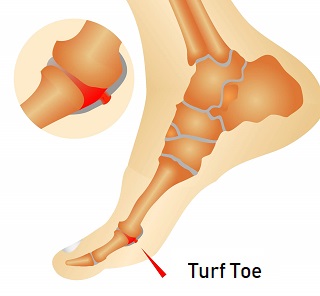
Turf Toe is a painful injury where there is damage to the structures around the big toe caused by hyper-extension, when the toe bends back too far.
It results in pain, swelling and stiffness around the big toe. It makes walking extremely uncomfortable and if left untreated, it can cause long-term problems.
Turf Toe is a common cause of toe pain in athletes playing on rigid surfaces such as artificial turf e.g. American football, soccer and basketball players, but also affects other athletes including gymnasts, ballerinas and wrestlers. The medical term for it is a metatarsophalangeal joint sprain.
Here we will look at the causes and symptoms of turf toe, how it is diagnosed, the best treatment options, the prognosis and recovery process and how to prevent it coming back or even developing in the first place.
What Is Turf Toe?
So what is Turf Toe? It is essentially a sprain of the soft tissues surrounding the big toe, known as a metatarsophalangeal joint sprain. There are three grades when classifying the toe sprain:
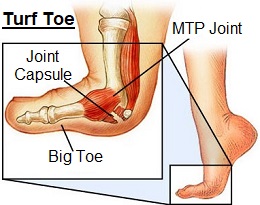
- Grade 1: Mild over-stretching
- Grade 2: Partial Tear
- Grade 3: Complete tear/rupture
The joint between the big toe and the foot is known as the metatarsophalangeal joint, MTP for short.
Surrounding this joint are a number of soft tissues including ligaments, a joint capsule and the plantar plate, which are known collectively as the plantar complex.
If these structures are over-stretched, the fibers in the plantar complex can tear. A metatarsophalangeal joint sprain is graded depending on how much damage there is to the plantar complex, as above.
What Causes Turf Toe?
A turf toe injury develops when the big toe is bent too far back into hyperextension, most commonly when front of the foot is fixed to the ground, the heel is lifted and a force pushes through the toe.
If the big toe gets bent back too far, the ligaments and/or the joint capsule underneath the big toe get over stretched and can tear. This often happens when pushing off to sprint, if you are tackled from behind, or fall forwards, and the foot stays flat on the ground.
Pain develops immediately with a metatarsophalangeal joint sprain and tends to get worse over the next 24-48 hours.
Turf toe injury can also develop gradually from repetitive, forced jamming through the big toe such as with quick pivoting, accelerating and jumping. When this is the case, the symptoms develop slowly and increase over time.
Metatarsophalangeal Joint Sprain Symptoms
The symptoms of Turf Toe vary depending on the severity of the injury:
Grade 1: Mild, localized pain with minimal swelling around the big toe
Grade 2: Moderate pain, swelling and bruising at the big toe and surrounding area
Grade 3: Severe pain, swelling and bruising around the joint and difficulty moving the big toe and walking
Pain can usually be felt immediately at the time of injury but may get worse over time as the swelling increases. With all grades there is usually some big toe pain when walking.
Risk Factors
Playing on artificial surfaces rather than grass increases the chance of developing a turf toe injury as the ground is harder and less flexible, putting more pressure through the toe.
A study in the American Journal of Sports Medicine looking at professional football players suffering from turf toe showed that 83% of them played on artificial surfaces.
Having hallux rigidus, a stiff big toe due to arthritis, can increase the risk of a turf toe injury, as can wearing flexible foot wear. Shoes that are flexible provide less support and allow the toe to hyperextend.
How Is It Diagnosed?
Your doctor can usually diagnose a metatarsophalangeal joint sprain from what you tell them about how the injury occurred, the sports you play and your footwear. They will examine your feet and may order an x-ray to check for signs of any damage to the bone, from either a fracture or arthritis.
#CommissionEarned from Amazon on qualifying purchases
Turf Toe Treatment
The aim of Turf Toe treatment is to reduce pain and inflammation, and protect the joint from further damage. Treatment will depend on the severity of the injury. As a guide:
- Grade 1 Injuries: usually settle within a few days and are best treated with a combination of PRICE and strapping
- Grade 2 Injuries: may require the use of a walking boot to immobilize the joint for around one week, and then strapping. They usually take a couple of weeks to settle
- Grade 3 Injuries: may require several weeks of immobilization with either a walking boot or a cast that holds the toe in slight flexion, followed by strapping or a turf toe brace and physical therapy to regain full range of movement
Common turf toe treatment involves a combination of:
1. PRICE
- Protect: To protect the big toe joint from further damage you should stop playing sport immediately and limit exercise. It is fine to keep walking with a metatarsophalangeal joint sprain, although you may need crutches if it is really sore
- Rest: The joint will need time to recover so you will need to rest from sports for a few weeks. You should avoid activities where you push through your toe such as running, and you may need to use crutches initially so you aren’t putting any weight through your foot at all when walking. In severe cases, you may be given a cast or special walking boot that stops the toe from moving altogether
- Ice: Regularly applying an ice pack for 10-20 minutes every 2 hours helps to reduce any inflammation. Find out how to safely and effectively use ice in the Cold Therapy section
- Compression: You can help reduce further swelling by wearing a compression bandage like tubigrip
- Elevation: keeping the foot raised higher than the level of your heart will help to reduce swelling e.g. with a leg cushion
2. Strapping
As part of Turf Toe treatment it can really help to strap or tape the big toe to the second toe. This helps to limit movement and reduce the stress on the big toe
3. Anti-Inflammatory Medication
Your doctor may advise a non-steroidal anti-inflammatory (NSAID) such as ibuprofen or naproxen to help treat the toe pain and inflammation with a metatarsophalangeal joint sprain. It is generally much better to take painkillers and be able to move around normally than to try and make do without them.
4. Physical Therapy
Mobilizations and exercises to stretch and strengthen the big toe will help prevent any long-term stiffness developing with a Turf Toe injury. This is particularly important with grade 3 injuries as the last thing you want is ongoing problems.
5. Surgery
In severe cases of metatarsophalangeal joint sprain, surgery may be required. This is usually if there is ongoing pain and instability or a bone spur has formed which limits toe movement.
How To Avoid Toe Sprains
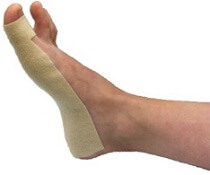
The best way to prevent a metatarsophalangeal joint sprain is to wear stiff-soled shoes e.g. ones containing a metal plate, that prevent the toe from bending too much.
You can also get a turf toe brace or special cushioned inserts that can help. Many athletes also use turf toe taping to keep their toes from bending back too far.
Playing on grass rather than artificial surfaces also helps reduce the risk of metatarsophalangeal joint sprain as it is softer and absorbs shock better.
Turf Toe Recovery
Full turf toe recovery usually takes three to four weeks, during which time complete rest from sport is required. It is really important to rest properly and not to return to sport too soon. If you keep aggravating the joint, the ligaments/capsule will not heal properly and recovery will take much longer.
Athletes who do not rest properly or address the cause of their metatarsophalangeal joint sprain are likely to develop long term problems such as arthritis and stiffness in their toe, known as hallux limitus.
Turf Toe Summary
Turf toe is a sprain of the big toe’s metatarsophalangeal (MTP) joint, caused by hyperextension or repetitive stress.
Symptoms include pain, swelling, stiffness, and difficulty walking.
Early treatment, rest, ice, strapping, and physical therapy, helps prevent long-term problems like arthritis or hallux limitus. Severe cases may require immobilization or surgery.
Prevent turf toe with supportive shoes, turf toe braces, taping, and by avoiding excessive play on hard surfaces. Prompt care ensures faster recovery and protects your toe’s long-term function.
There are a number of other causes of big toe pain such as hallux rigidus (stiff big toe) and bunions. If turf toe isn't sounding quite like your problem, visit the toe pain section. Alternatively, if you want help working out what is causing your pain, visit the foot pain diagnosis section.
Related Articles
References
- Turf Toe Injury. British Orthopaedic Foot And Ankle Society
- Turf Toe Injuries in the Athlete: an Updated Review of Treatment Options, Rehabilitation Protocols, and Return-to-Play Outcomes. National Institute Of Health, NIH
- Turf Toe. Healthline
Page Last Updated: 9th January, 2026
Next Review Due: 9th January, 2028
